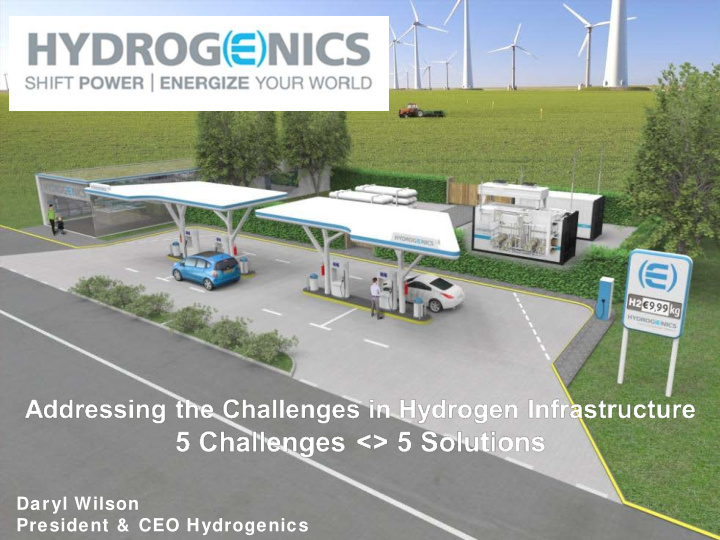



Daryl Wilson President & CEO Hydrogenics
Five Challenges of Fuelling Infrastructure 1. Challenge to innovate 2. Challenge to address funding & cost 3. Challenge to preserve green attributes 4. Challenge to find fresh business models 5. Challenge to think energy systems Source: Pike Research, Markets and Markets, and Wall Street Research Confidential - Do not duplicate or distribute without written permission from Hydrogenics Corporation 2
There is a world of experience to harvest here! With more than 300 global fueling installations More than 40 within Hydrogenics portfolio Some Lessons Learned Reflection is Timely + - ! Confidential - Do not duplicate or distribute without written permission from Hydrogenics Corporation 3
WaterstoNet, Brussels, Belgium 65kg/day, 350bar 4
Ruter/AL, Oslo, Norway 260kg/day, 350bar 5
Challenge: Innovation The Problem: We use what we have rather than challenge what is needed A positive approach: Linde Ionic Compression Hydrogenics Contribution: Next Gen. MW Class PEM Water Electrolysis 6 x spatial improvement in onsite generation 2MW > 12MW = 5000kg/d = 1000 cars Some recommendations: 1. Future JTI programs to reward innovation 2. Set targets to drive innovation 3. Ongoing Technology road mapping
700bar Fueling Station Setup 6 meters 9 meters 700 bar Module 2: Compression, Dispenser Module 1: Electrolyser cooling, booster , 850bar storageand (21,32, 65, 97 or 130kg/day) Storage management system Hydrogen quality: Fuel Cell Grade (99,998%) Fill type: According to SAEJ 2601 requirements Consumption: 68 kWh/kg H2 produced Fully interconnected and centrally controlled 7
Vattenfall, Hamburg, Germany Largest European H 2 Station owned by a utility 1 MW Hydrogenics Electrolyser – Project by Linde 8
Challenge: Cost & Funding The Problem: After billions of vehicle R&D we are stuck on who pays for communal assets A positive approach: Mitsui cost target challenge Hydrogenics Contribution: Scale merit of increased demand n=100 pricing Cost reduction in balance of plant design “eliminate” Energy system integration with storage & stabilization Some recommendations: 1. Cost mapping of all costs followed by reduction challenge 2. Risk management, standards & safety best practices 3. Business model & energy systems approach has impact 4. Vehicle / infrastructure agreements which plan for funding
Postauto, Brügg, Switzerland 130kg/day, 350bar 10
Challenge: To Preserve Green Attributes The Problem: After developing a power train capable of 90%+ GHG / CO2 emissions reduction we settle for just 55% (less than half) A positive approach: California “Green H2 incentive” Hydrogenics Contribution: Increased electrolysis current density and efficiency to 90% Create total life cycle cost model which delivers on target Some recommendations: 1. Incentivize green hydrogen pathway over alternatives 2. Allocate capacity in favour of green pathway
Electrolysis: 450 > 42 g CO2/mile = 90% Reduction NG: 450 > 200 g CO2/mile = 55% Reduction
Challenge: To think of business models The Problem: We are quickly trapped in the old paradigm of commodity delivery rather than thinking about the total business model A positive approach: California station owner incentives Hydrogenics Contribution: Energy storage and stabilization services (patented) Create total life cycle cost model which delivers on target Some recommendations: 1. Consider the value of energy services for electrical grid 2. Consider local energy dynamics in time 3. Consider available or forecasted “surpluses”
Increasingly we have “excess” electricity 14 Confidential - Do not duplicate or distribute without written permission from Hydrogenics Corporation
Hydrogen Fueling Station Control and Optimization Grid
Challenge: To think of total energy systems The Problem: We continue to see fueling infrastructure as an isolated element of the total energy system and fail to recognize synergies. A positive approach: No one has done this yet! Hydrogenics Contribution: Energy storage and stabilization services (patented) Flexible operating regime for electrolysis with “overdrive” Some recommendations: 1. Integrate the shock absorbing attributes of electrolysis 2. Develop economic models for electricity price and services 3. Treat fueling as part of a whole system / operate as such
What is Power-to-Gas? A Power-to-Gas Solution brings new economic and technology flexibility between the traditional energy silos of power grids, gas pipelines and transport Source data: National Energy Board secondary energy demand forecast, Rethinking Energy Conservation in Ontario, May 2010 report 17
A Virtuous Cycle with electrolysis
Hydrogenics’ team added value • Direct contact with the manufacturer • Dedicated Technology and R&D team • 60 years of experience and professionalism • Over 45 fueling stations delivered worldwide • Safety and reliability is our main concern • Design, production and startup by Hydrogenics • Worldwide start-up and After-sales service • Full maintenance contract possibility • Recognized by major companies 19 Confidential - Do not duplicate or distribute without written permission from Hydrogenics Corporation
Confidential - Do not duplicate or distribute without written permission from Hydrogenics Corporation 20
Recommend
More recommend